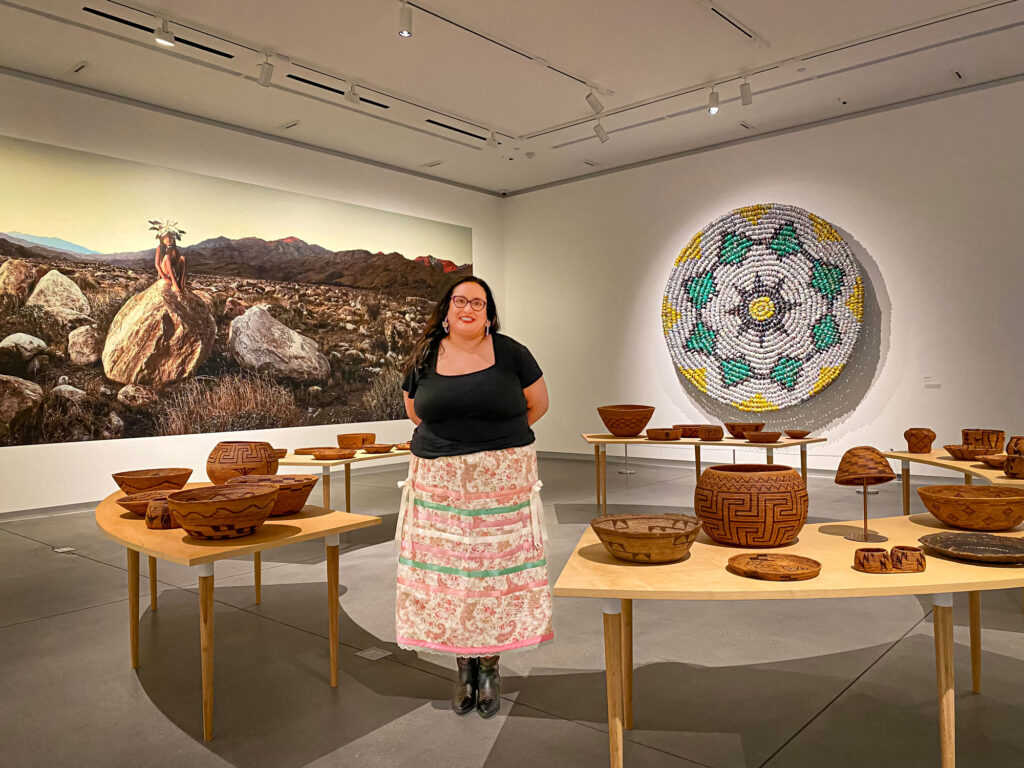 Meranda Roberts at “Continuity: Cahuilla Basket Weavers and their Legacies” at Benton Museum.
Meranda Roberts at “Continuity: Cahuilla Basket Weavers and their Legacies” at Benton Museum.
Meet Meranda Roberts, a curator and Native Scholar in Residence at Pitzer College’s Community Engagement Center (CEC) this semester. Roberts is a citizen of the Yerington Paiute Tribe and Chicana. She has a PhD in Native American History and an MA in Public History from the University of California, Riverside.
Roberts guest-curated the exhibition, “Continuity: Cahuilla Basket Weavers and their Legacies,” open at the Benton Museum of Art at Pomona College now through June 23. She is also a visiting professor at Pomona College.
Learn more about Roberts in this Q & A:
What have you worked on as a Native Scholar in Residence?
I think The Claremont Colleges struggle with retaining Indigenous faculty and students. Students reached out to me because they were feeling pressured to fill initiatives. I’ve been helping the students think of policies for when faculty and departments reach out about land acknowledgments. We’re also working on policies about engagement with the CEC. People think this center and these students exist for Indigenous representation, but they’re here to get an education like everyone else. I wish there were more opportunities where students didn’t feel like the only Native.
Every Friday, I sit at the Barbara Drake Talking Circle to mentor. I have a doctorate and I’m a first-generation scholar, so I’ve been through almost everything. I involve students in my events at Benton Museum so that they can meet artists and people from different occupations.
How does your Native heritage inform your work?
I’m also Chicana. It’s important to identify the space you’re taking. I was taught from an early age to make things better for the next generation. My career is working with non-Native people so that they better understand us while also honoring Indigenous sovereignty.
I was just having a conversation about Paiute people and how we’re real stubborn, but we get things done. I think it’s because we’ve survived in the desert for so long. I get angry at the systems that keep us oppressed. I want to work against them and use Indigenous methodologies. It’s not easy. Institutions don’t like being pushed.
It’s about getting people to understand that what they’ve been taught about Native people is wrong (if they’ve been taught anything about us). Numu means “human being” in our language. That’s how I approach people, on a human level.
Tell us about the exhibition at Benton Museum.
I began curating it in 2020. I was a co-curator at the Field Museum of Natural History, and my dissertation is about women basket weavers. The director of Benton approached me about their collection of baskets.
Emil Steffa, a Pomona College graduate and an anthropologist in the 1900s, collected these baskets from Cahuilla people. He took their names and photographs, which wasn’t standard then. When I looked at his materials, it made sense to connect them to the community. I’d worked with Cahuilla basket weavers. It was my responsibility to let them know about this collection and for the museum to establish a relationship with them.
Instead of taking Steffa’s word at face value, I looked at it from a Native woman perspective. When he talked about befriending people, I questioned that. He recorded certain men’s names but not women’s. He believed that Native people were primitive and would disappear. We are here and have always been here.
The exhibition includes Cara Romero’s work, Emily Clarke’s poetry, Gerald Clarke’s basket installation made of cans, among other things. All the baskets are arranged in a circle that you can walk through without touching them. There’s no glass, which freaks people out, but it’s needed.
What’s next after this residency?
I’m teaching a class at Pomona in the fall called Reclaiming Native American Art. We’re looking at the colonial origins in museums and whether decolonizing is possible. I’m also on the scholarly committee for the new Smithsonian American Women’s Museum.
Education has been used as a tool for settler colonialism and assimilation. What do anti-colonial practices in education look like to you?
Whether they’re a university or museum, these places were never made for people of color. As an Indigenous person you have knowledge, but learn how to say no. You don’t want to be tokenized. If you fight every battle and go into everything angry, you’ll burn out.
Pace yourself. Know who’s safe. Realize these are competitive spaces. Don’t do more than what you can. Even though faculty are teaching you, what you know is what you know. Speak up. Know when to walk away. A lot of things happening in the world are ignored in class, but it’s our responsibility to help students work through that.
Learn more about Meranda Roberts.
Learn more about the exhibition “Continuity: Cahuilla Basket Weavers and their Legacies.”